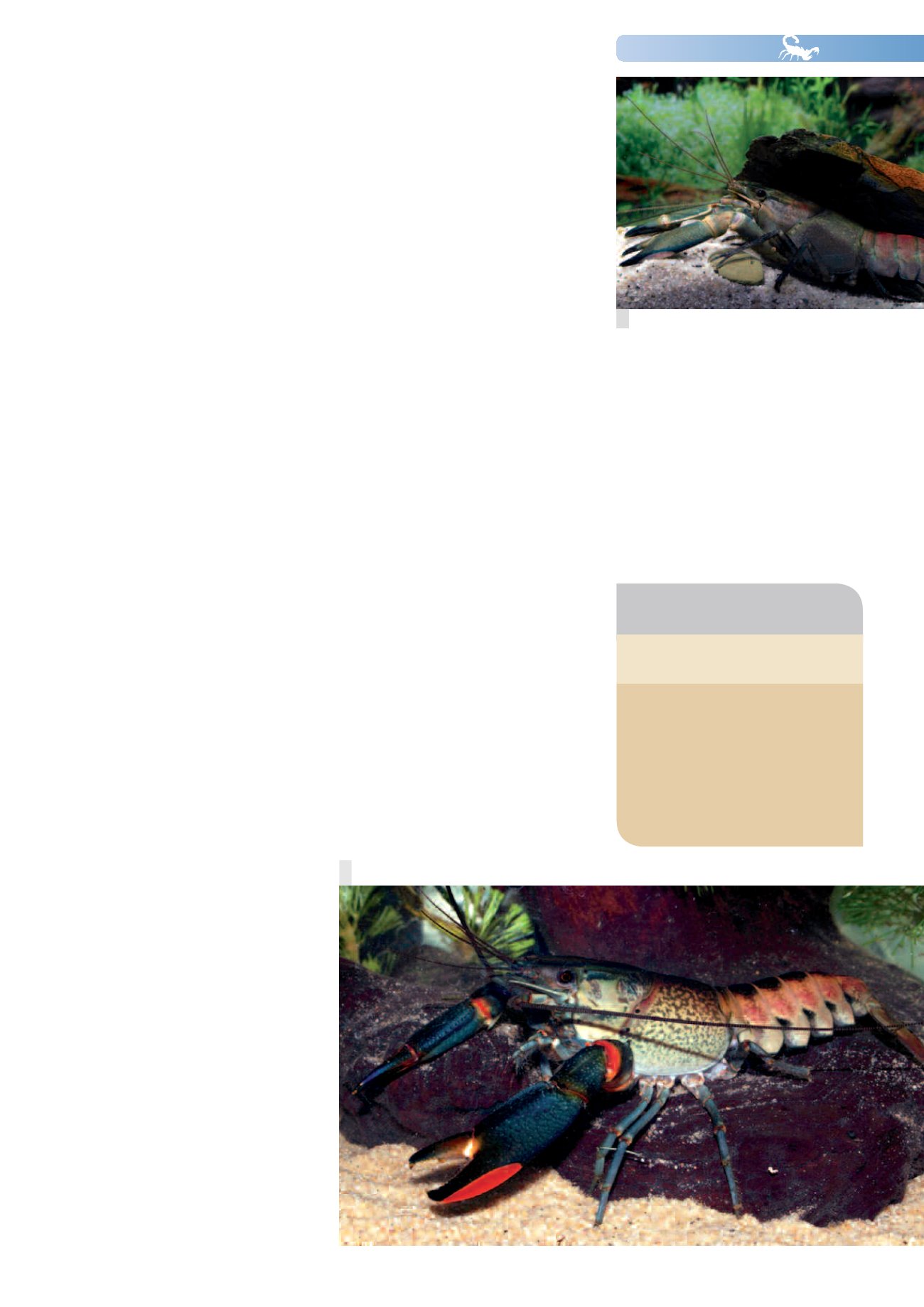
NEWS106
47
Cherax
sp.„Rusty“ in itscave.
Male
Cherax lorentzi
.This species isundoubtedlyclosely related to thenewly imported species.
Lexikon
NewGuineacrays
Cheraxmeans“engraved”or“chise-
led”
Astaconephrops:acombinationof
thegenusnamesAstacusandNe-
phrops, twoother crayfishgenera
lorentzi:namedafter thediscoverer
of the species,HendrikusAlbertus
Lorentz (1871-1944)
pairofwalking legs,while thatof the female
is at thebaseof the secondpair.Likeall de-
capodcrustaceans,
Cherax
have fourpairsof
walking legs.Thesexualopeningsarevisible
as lightdotsand thescientific term for them
isgonopores.
Relatively small andpeaceful
Thesixspeciesof thesubgenus
Astaconeph-
ros
known todate - specifically
Cheraxalber-
tisii,C.boesemani,C.lorentzi,C.minor,C.misoli-
cus
, and
C.monticola
- areofmoderate size,
growing toamaximum15cm longbutusu-
ally remaining significantly smaller.Thenew
species is apparentlymost closely related to
C.lorentzi
.Hence it isprobably reasonable to
assume that itsmaintenance andbreeding
requirements don’t differ appreciably from
thoseof
C.lorentzi
,whichhasalreadybeen in
thehobby foranumberofyears.
Mainly scavengers
Fluviatilecrayfishesare–generallyspeaking
-opportunists thateatwhatevercomeswit-
hin rangeof their claws.Todateno trophic
specialistsareknown.Butthereareneverthe-
lessdistinctdifferences inthebehaviorofthe
variousspecies.Forexample,it isnotwithout
reason that
Cheraxquadricarinatus
has be-
come one of the most important species
worldwide ineconomictermsandbred in its
millions for food.Ofall the rivercraysknown
todate it isthe fastest-growingandprovides
thegreatest yield.Sucha species canbeex-
pected toeat everything that comes along,
and in largequantities.Bycontrast thesmall
species
C.lorentzi
feedsmainlyondeadplant
material.Thenewspecies,whichwewillpro-
visionally call
Cherax
sp.“Rusty”(becauseof
itsattractive red-brownarmor),was first im-
ported by Aquarium Glaser in December
2012. Since then three of these crays have
been living inarelativelysmallaquarium (40
x40x40cm) togetherwithsix
Ancistrus
cat-
fishes around5cm long.Thesecrays always
haveasmany leavesastheyrequireavailable
as food.Under these conditions therehave
beennoattacksof anykindby the crayson
the suckermouth catfishes,althoughoneof
theAncistrusmales has evenbeen sharing
the cavewithoneof the crays.Various snail
species sharing the aquariumhave also re-
mainedunscathed. It can thus be assumed
that
Cherax
sp.“Rusty”isaverypeacefulcray-
fishspecies thatcangenerallybekept in the
companyof fishes, though therealways re-
mainsasmallelementof risk insodoing.
Gourmet tastes?
Ithasbeenfoundthat
Cherax
sp.“Rusty”ispar-
ticularly fond of the leaves of cherry trees,
while thoseofAspen,forexample,are largely
ignored.Sothespeciesdoeshavecertainpre-
ferenceswhen it comes to feeding.Wecan’t
yet say how
Cherax
sp. “Rusty”behaves to-
wards aquaticplants,but the species, likeall
Cherax
species,willdig if it isn’tprovidedwith
sufficient hiding-places. It is tobeexpected
that insuchcases largerspecimenplantswith
an extensive root zonewill be undermined
andpossiblyuprooted.Toavoidsuchmishaps,
valuableplantsshouldn’tbegrown incrayfish
aquaria, but fast-growing stemmed plants
used instead,as theycan ifnecessary survive
floatingunrooted intheaquarium.
Sensibledécor
Aswithallaquarium livestock,it isprimarily
the expertiseof the aquarist that determi-
neswhether andhowmuchharm an ani-
mal causes in the tank.Craysareall crepus-
cular and nocturnal and require cover by
day.Thismeans that theymustbeprovided
withhiding-places. Inorder to simultane-
ouslyget toseesomethingof thecrays,it is
advisable to lean a flat stone or similar
against the frontglassof theaquarium.The
crayswill seekshelter therebutyouwillne-
verthelessbeable toobserve themwithout
problem.The area around the cave should
be left unplanted, as the little diggerswill
undertake home improvements here. So
with a littleeffort you can keepboth sides
– thecrayand itsowner –happy!


